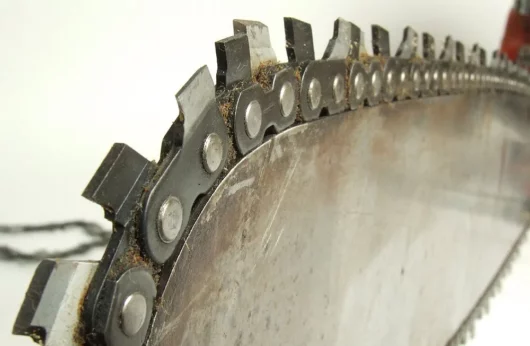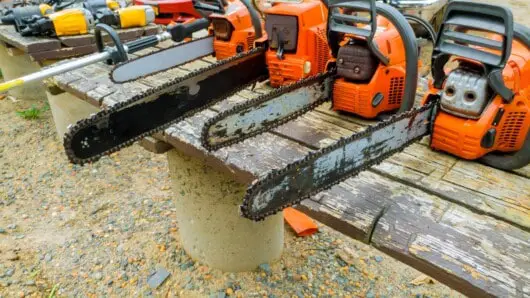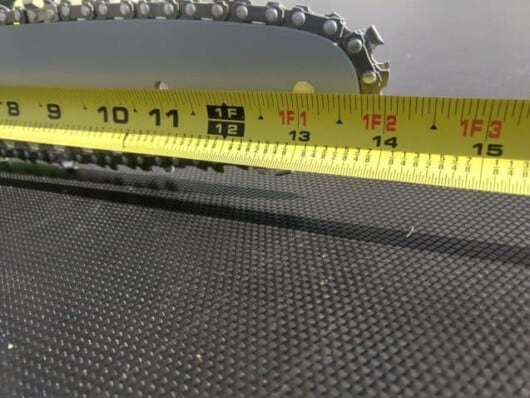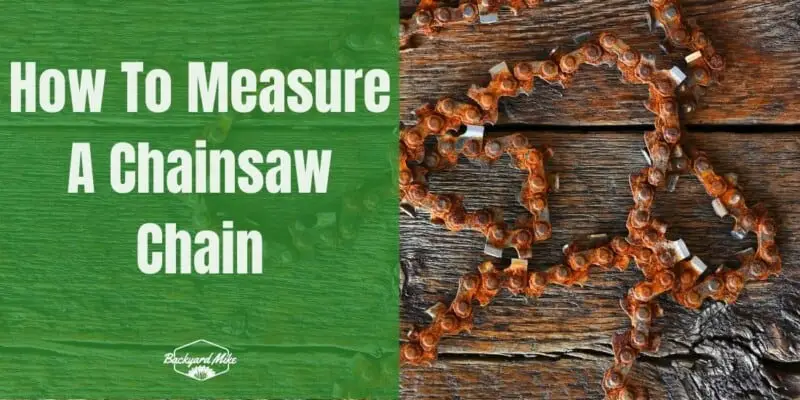Chainsaws are an essential tool for any homeowner or professional. Keeping the chainsaw chain in top condition is important, and part of that is making sure the chain is the right length. This article will explain everything you need to know about measuring a chainsaw chain length and how to do it properly. So whether you’re a beginner or an experienced chainsaw user, read on to find out how to measure your chainsaw chain length in no time!
Overview of measuring a chainsaw chain
Chainsaws are powerful tools that are versatile and capable of carrying out a variety of jobs, including arborists and landscapers. This important tool will make it easier and faster for handling different tasks, including everyday jobs and heavy-duty tasks. Just like any other type of power tools out there, a chainsaw will also need regular maintenance. One of the parts that need regular changes will be the chainsaw chain.
However, it is worth mentioning that chains are not universal. The chain for your chainsaw needs to fit your machine. There are three different types of measurements that you’ll need to know for your chainsaw – the gauge, the pitch, and the number of drive links. These numbers are typically located on the side of the chainsaw bar. However, if you cannot find them, you can measure them yourself.
Why are chainsaw measurements important?
The simple answer to this question will depend on the three measurements outlined above. Generally, the gauge, the pitch, and the drive links in the chainsaw will help you determine the cutting method appropriate for your chain. With that said, chainsaw chains having a pitch of 0.404 inches will be best for heavy-duty tasks. These types of chainsaws are usually used by firemen and other tasking operations that need a lot of power.
With the distance between the links getting wider, the cutting will gradually become much more aggressive. On the other hand, chains having a pitch of 0.325 inches are better suited for light or low-profile cutting. These chains are normally found on chainsaws having bar lengths of not up to 18 inches. These machines are generally medium-sized, and they’re commonly used in non-professional applications.

What will you need for measuring a chainsaw chain?
When it comes to measuring a chainsaw chain, it’ll be important that you have the right tools and safety equipment on hand. Proper measurement of the chain will ensure that it fits your chainsaw properly and runs smoothly, which not only helps you get ideal performance but also reduces the risk of accidents or damage. Carrying out the preparation for the process beforehand will help you carry out the entire thing.
Required tools and equipment
- Ruler or tape measure – The first tool that you will require is a tape measure or ruler. You should use it for measuring the length of the chain and pitch or the distance between the drive links.
- Chain gauge – A chain gauge is used for measuring the depth of the chain’s teeth. It’ll be important to have the correct gauge for the chainsaw to ensure accuracy.
- Flat file – You’ll require a flat file for sharpening the teeth of the chain if needed. You should ensure that the file is the correct size for the chain.
- Vise – A vise will hold your chainsaw in place while you’re working. Further, it’ll also make it easier to measure and adjust the chain.
Safety precautions
- Gloves – Chainsaws are dangerous tools, and it’ll be important that you protect your hands from cuts or scratches. You must wear heavy-duty work gloves for keeping your hands safe.
- Ear and eye protection – Chainsaws are loud and could result in hearing damage. They can also kick up debris that can potentially injure your eyes. You must wear earplugs or earmuffs and safety goggles for protecting yourself.
- Chainsaw chaps – Chainsaw chaps are protective clothing designed to stop the chain if there’s any accident, and it comes in contact with your legs. They’re made using heavy-duty fabric capable of stopping the chain from cutting through.
How to measure chainsaw chain
Determine the pitch of the chain
The pitch of the chain is the distance between three consecutive rivets divided by two. The pitch is a measurement used for denoting how close the links are on the chainsaw chain. This is also referred to as the average distance between two successive chain links. To get the pitch, you will need to measure the distance between three rivets at any point on the chain before dividing the result by two.
Here is how you can determine the pitch –
- Remove the chain from the chainsaw – First, you’ll need to remove the chain from the chainsaw before laying it out on a flat surface
- Measure the distance between three consecutive rivets – Then, you should use a ruler or tape measure for measuring the distance between three consecutive rivets
- Divide the distance by two – Lastly, you will have to divide the distance by two, and you’ll be able to determine the pitch of the chain
The pitch is typically printed or stamped on your chainsaw’s drive link. The most common pitches in chainsaw chains are – 0.325”, 3/8”, or 0.404”. The pitch is also displayed on the guide bars at times, but it is not always the case. This is where direct measurement will come in. The pitch affects the drive link while also affecting the length of the blade.
Measure the chain’s gauge
The gauge of chainsaws is the measurement that determines how deep the groove is on the guide bar. Basically, it is the thickness or depth of the drive links. This measurement needs to be accurate. If the chain is too loose, you won’t be able to get enough lubrication to the guide bar.
Meanwhile, if the gauge is too thick, it won’t run on the guide bar properly. These two factors must be considered, as you might end up causing damage to the guide bar if they aren’t accurate. Here is how you can measure the chain’s gauge –
- Determine the size of the chain gauge – Check the specifications of your chainsaw for determining the size of the chain gauge
- Use a chain gauge tool – Make use of a chain gauge tool for measuring the thickness of the drive link. Just place the tool over the drive links before checking the reading
The most common sizes for the gauge tend to be 0.043” (1.1 mm), 0.050” (1.3 mm), 0.058” (1.5 mm), and 0.063” (1.6 mm). You will be able to find the gauge on the side of the chainsaw bar.
Measure the length of the chain
The length of the chain will be important to make sure that it fits properly on your chainsaw. Here is how you can measure the length of the chainsaw chain –
- Measure the length of the chain – Lay down the chainsaw chain on a flat surface and measure the length from one end of the chain to the other
- Check the specifications – Check the specifications of your chainsaw for ensuring that the length of the chain matches perfectly the recommended size
Measure the number of drive links
Drive links are basically the sharp, triangular extensions that are present on the underside of the chainsaw chain. They are responsible for keeping the chain attached to the bar. This feature will give you the necessary information on how long the chain is and whether it’ll fit into your bar. The measurement is quite easy to take, but it can get frustrating at times. Here is how you can measure the number of drive links –
- Remove the guide bar – First, you will need to remove the guide bar side panel using a wrench before releasing the tension of the chain using a screwdriver
- Place the chain and arrange it – For making counting the drive links easier, you will need to place the chain on a flat surface and arrange it in a way the drive links align across each other
- Count the number of drive links – Once you have laid out the chain, you’ll be able to count pairs of drive links rather than counting them one after the other, making it easier to count the number of drive links
- Check the specifications – Check the specifications of the chainsaw to make sure that the number of drive links are matching the recommended size
How to measure the effective cutting length of a chainsaw?
Typically, chainsaws are sold in even-numbered lengths based on the length of the chainsaw bar. Also known as a chainsaw blade, the chainsaw bar is the metal “arm” holding and supporting the chain during cutting. When you purchase a 16-inch chainsaw, you’re buying a chainsaw with a 16-inch bar.

You’ll be able to measure chainsaw bars in two different ways. The most common method is the effective cutting length. This is the distance from the tip of the bar to the front of the chainsaw body, where the chainsaw bar disappears into the chainsaw. For measuring the chainsaw’s effective cutting length –
- Place a tape measure or ruler at the tip of the bar
- Now, measure right back to the point where the bar is entering the chainsaw body
- Round off the measurement to the nearest even number
As chainsaws are only sold in even numbers, you should round up odd numbers and fractions. A chainsaw having a 15-inch effective cutting length will be a 16-inch chainsaw. If you get the measurement 18 ¾ inches, it’ll be a 20-inch chainsaw.
The true bar length is the second form of measurement, and it is the less commonly used one. If you have to get a perfect fit for the replacement bar, then here is how you can do it –
- Loosen the bolts that are holding the bar to the chainsaw body
- Remove the bar before placing it on a flat surface
- Measure the bar from one end to the other
The true bar length of the chainsaw is a precise measurement. You shouldn’t be rounding up this number.
Tips and tricks for measuring a chainsaw chain
Measuring the chainsaw chain is an important aspect of maintaining your chainsaw and ensuring that it cuts safely and efficiently. Taking accurate measurements of the chainsaw pitch, gauge, chain length, and the number of drive links will be necessary for determining the correct replacement chain, sharpening, and filing the chain, or purchasing additional accessories. It is worth noting that specific steps for measuring chainsaw chains can vary depending on the manufacturer and model of the chainsaw. Getting accurate measurements can be somewhat tricky, especially for beginners. Here are the tips and tricks that you should be used when measuring a chainsaw chain –
#1. Check the manufacturer’s specifications
Before you measure your chainsaw chain, it’ll be important that you check the manufacturer’s specifications to make sure you’ve got the correct chain size for your chainsaw. You can find this information in the owner’s manual or on the manufacturer’s website. The owner’s manual will also give you precise instructions on how to measure the chain length, gauge, pitch, and the number of drive links.
#2. Mark the chain at its midpoint
For accurately measuring the chainsaw chain, you will have to mark it at its midpoint. It will help you accurately measure the length of the chain and determine the number of drive links. For marking the chain at its midpoint, you’ll need to fold the chain in half and make a mark at the point where the two ends meet.
#3. Measure the chain with a ruler
For measuring the length of the chain, you need to use a ruler or tape measure. Begin at the mark that you made at the midpoint of the chain. After that, you’ll have to measure the distance to the end of the chain. This measurement will give you the overall length of the chain.
#4. Count the drive links
The number of drive links on the chainsaw chain is also important for ensuring that it fits on the chainsaw properly. For counting the drive links, you must begin at one end of the chain and count the number of links until you reach the midpoint. After that, repeat the process on the other half of the chain. Add the two numbers together, and you will get the total number of drive links.
It is important to remember that some chains have a different number of drive links on each half of the chain. If that is the case, you’ll have to count the drive links on each half of the chain separately.
#5. Take the necessary safety precautions
Before you measure the chainsaw chain, ensure that you’re taking appropriate safety precautions. You must wear the necessary safety gear, including gloves, ear muffs, eye protection, chainsaw chaps, and more. Further, you should also unplug or remove the battery from the chainsaw when taking the measurements.
#6. Use the right tools
You should be using the right tools when you’re measuring the chainsaw chain. Those tools include a measuring tape, ruler, and chain gauge. Using the correct tools will help you take accurate measurements and make sure you get the correct replacement chain.
#7. Clean the chain
Clean the chainsaw chain and remove any dirt or debris before you measure it. This will help you in getting accurate measurements and preventing damage to the measuring tools.
#8. Measure the chainsaw chain in a flat area
Measuring the chainsaw chain on a flat surface will help you get accurate measurements. You need to place the chain on a flat surface and make sure that it is free from any kinks or twists.

#9. Mark the chain
Marking the midpoint of the chain with a marker or a piece of tape will make the measuring process much easier. This will allow you to get accurate measurements off the chain’s length and the exact number of drive links.
#10. Take your time
You must take your time when you’re measuring the chain. Do not rush through this process. It’ll be better if you take your time so that you’re able to get accurate measurements, than to rush and end up getting the wrong size of the chain.
Troubleshooting common chainsaw measurement issues
When you’re taking measurements of the chainsaw, certain measurement issues can arise. They can easily lead to incorrect pitch, incorrect gauge, incorrect length, and other issues that’ll you’ll need to troubleshoot. Here is how you should address those issues –
Incorrect pitch
If the pitch of the chain is incorrect, it will not fit on the chainsaw bar properly. The pitch is essentially the distance between the center of two adjacent rivets, and it’ll be critical to match the pitch of the replacement chain to the chainsaw bar. If you find that the pitch isn’t correct, the first step would be to verify that you have measured the pitch correctly. After that, check the chainsaw bar and ensure that it matches the pitch of the replacement chain. If you’ve got the wrong pitch, you’ll have to purchase the correct chain size.
Incorrect gauge
If the gauge of the chain is incorrect, it might not fit snugly into the groove on the chainsaw bar. The gauge will be the thickness of the drive links, and it is critical that it matches the gauge of the replacement chain to your chainsaw bar. If you find that the gauge isn’t correct, you should first verify that you have measured the gauge of the replacement chain. If you don’t have the right gauge, you must purchase the correct size chain.
Incorrect length
If the length of your chainsaw chain is incorrect, it won’t fit on the chainsaw bar properly. Moreover, it might not operate efficiently. For troubleshooting incorrect chain length, you should first double-check the measurement. After that, ensure that you have counted the number of drive links accurately. If you’re confident that the measurements are correct, you should check the chainsaw bar for ensuring it is the correct length for the replacement chain. If the chainsaw bar is of the correct length, you’ll have to purchase the correct size chain.
Incorrect number of drive links
When getting the incorrect number of drive links, the chain won’t fit on your chainsaw bar properly. For troubleshooting this issue, you need to double-check the measurement and count the drive links again. If you’re confident that the measurement is correct, you should check the chainsaw bar for ensuring that it is the correct length for the replacement chain. If the chainsaw bar is of the correct length, you will need to purchase a new chain that has the correct number of drive links.
FAQs
What is the best way to measure a chainsaw chain?
The best way to measure a chainsaw chain is to measure the length of the chain from the tip of one cutter to the tip of the opposite cutter. This will give you the length of the chain in inches, which is usually the same as the size of the chain in inches. Additionally, you can measure the length of the guide bar, which is usually marked in inches, to determine the size of the chain you need.
How do I measure the length of the guide bar of my chainsaw?
The length of the guide bar on a chainsaw can be measured by laying a measuring tape along the top of the bar, from the tip to the back of the bar where it meets the motor housing. The measurement should be taken in inches and is usually marked on the bar, which will give you the size of the chain you will need.
What should I consider when selecting a chainsaw chain?
When selecting a chainsaw chain, you should consider the cutting needs of the specific job, the type of material you are cutting, and the size of the guide bar. There are several different types of chains available, each with its own advantages and disadvantages. It’s important to do your research and find the chain that is best suited for your needs.


